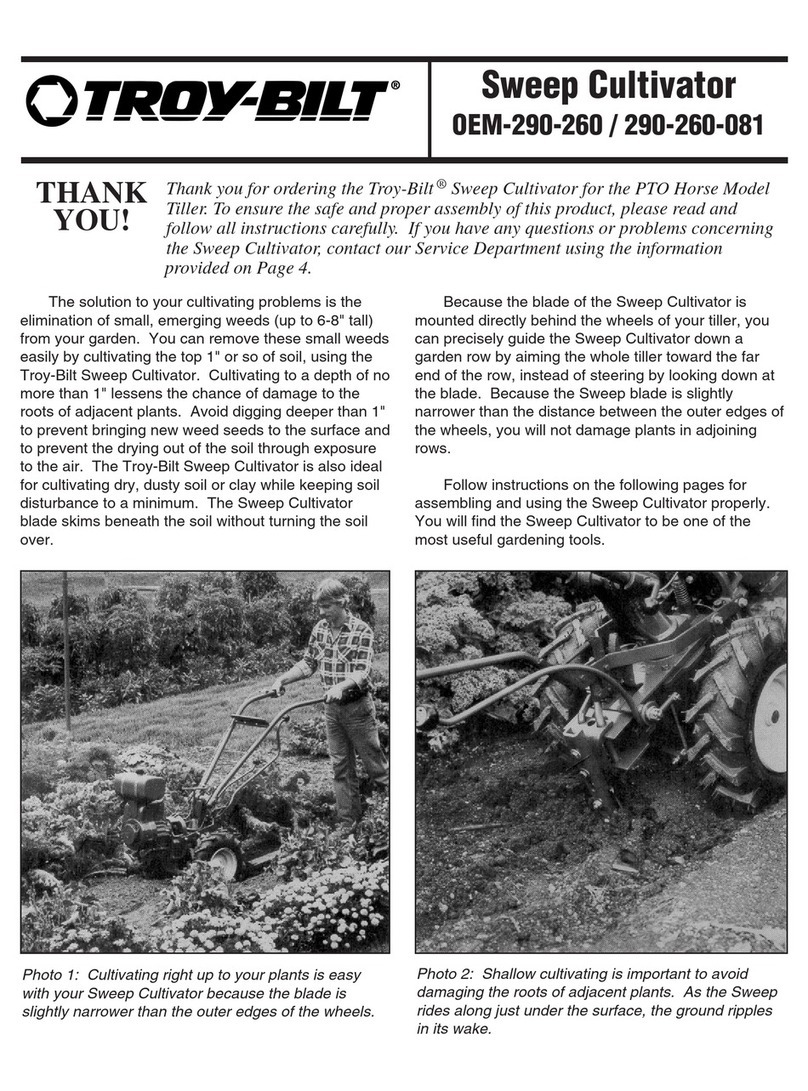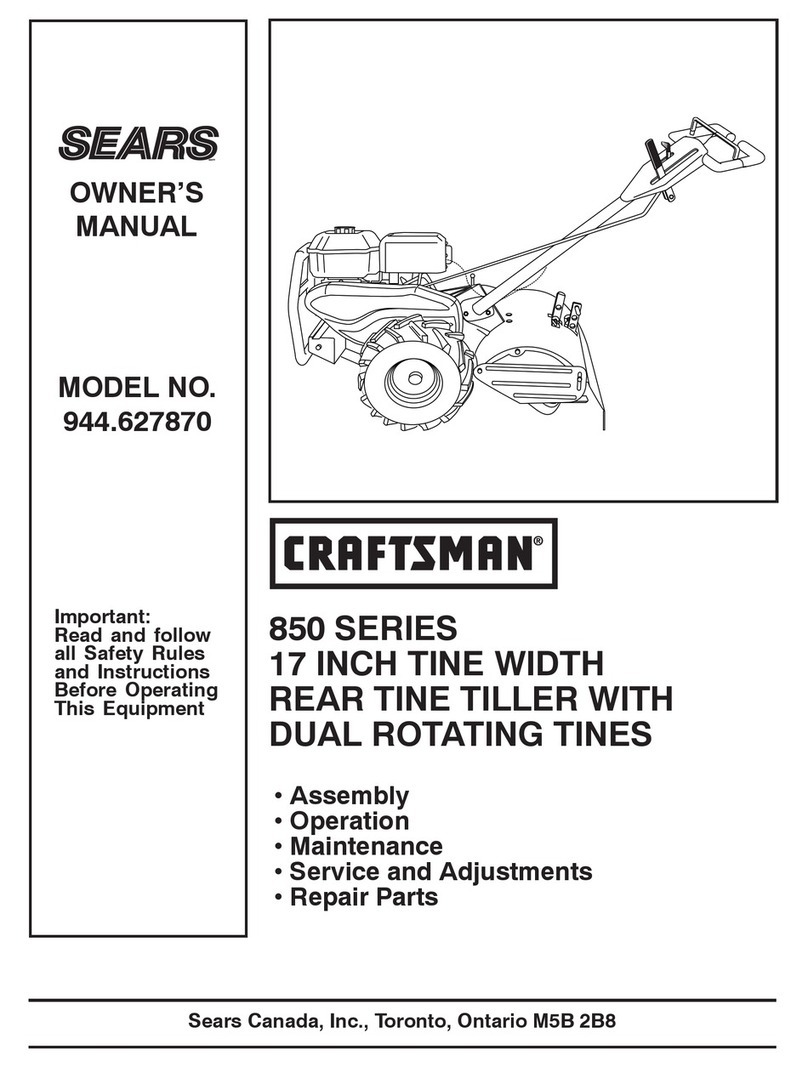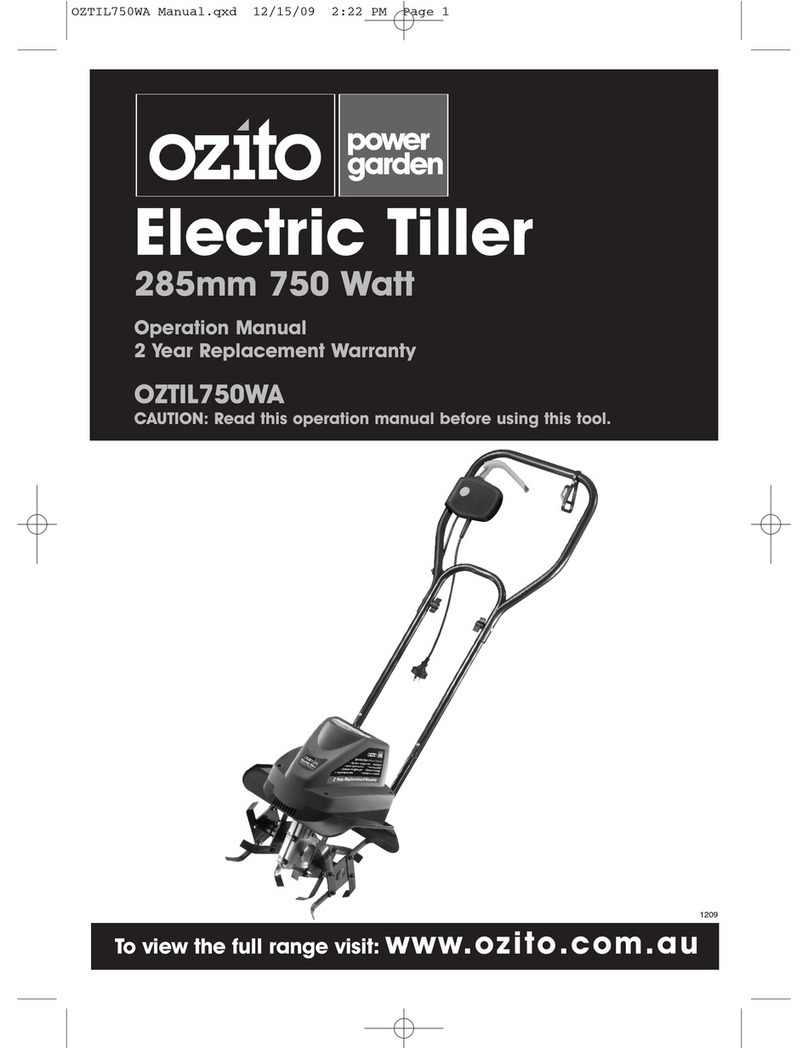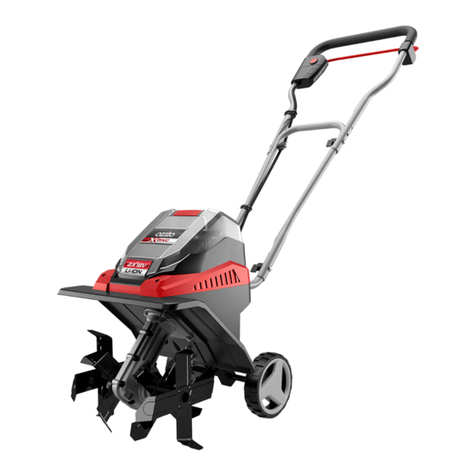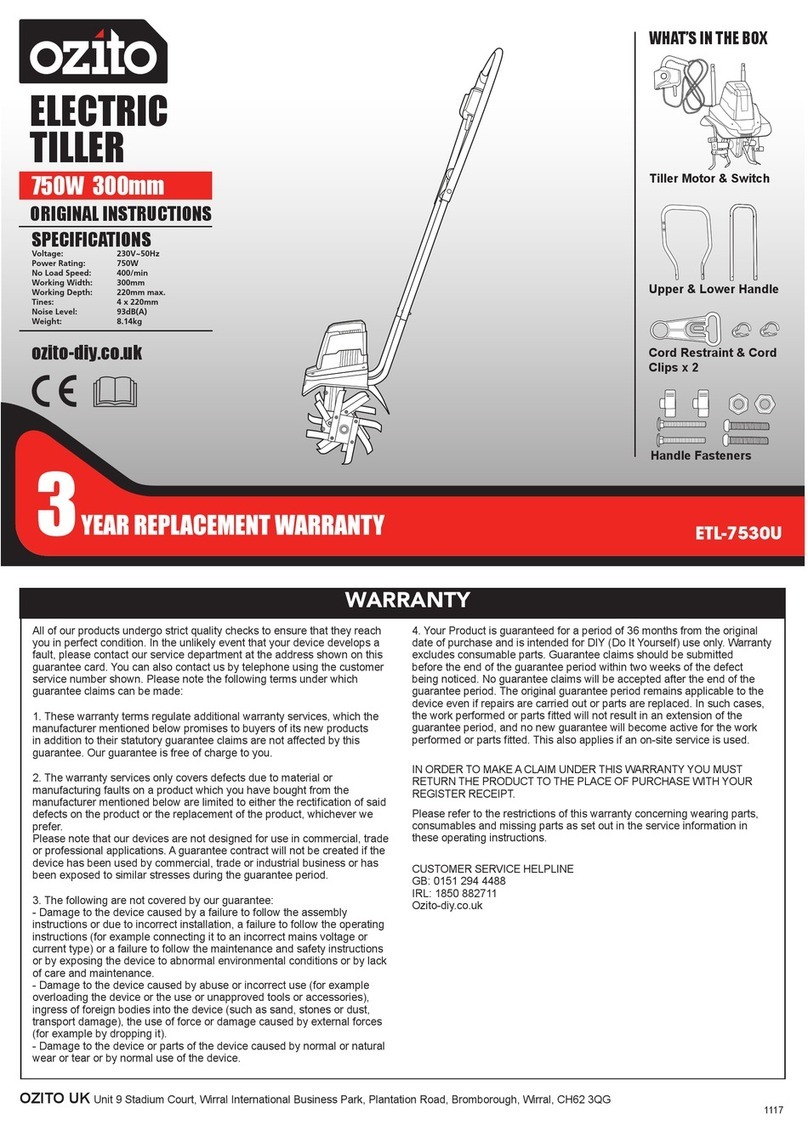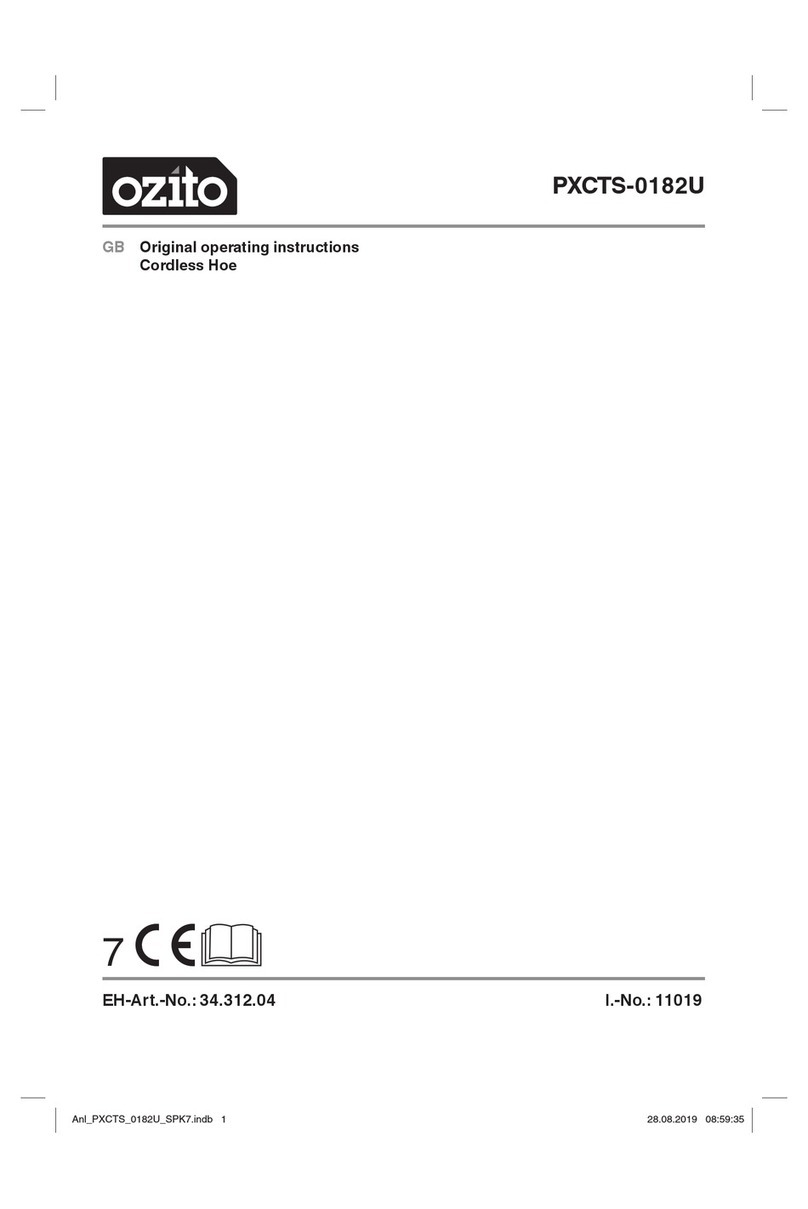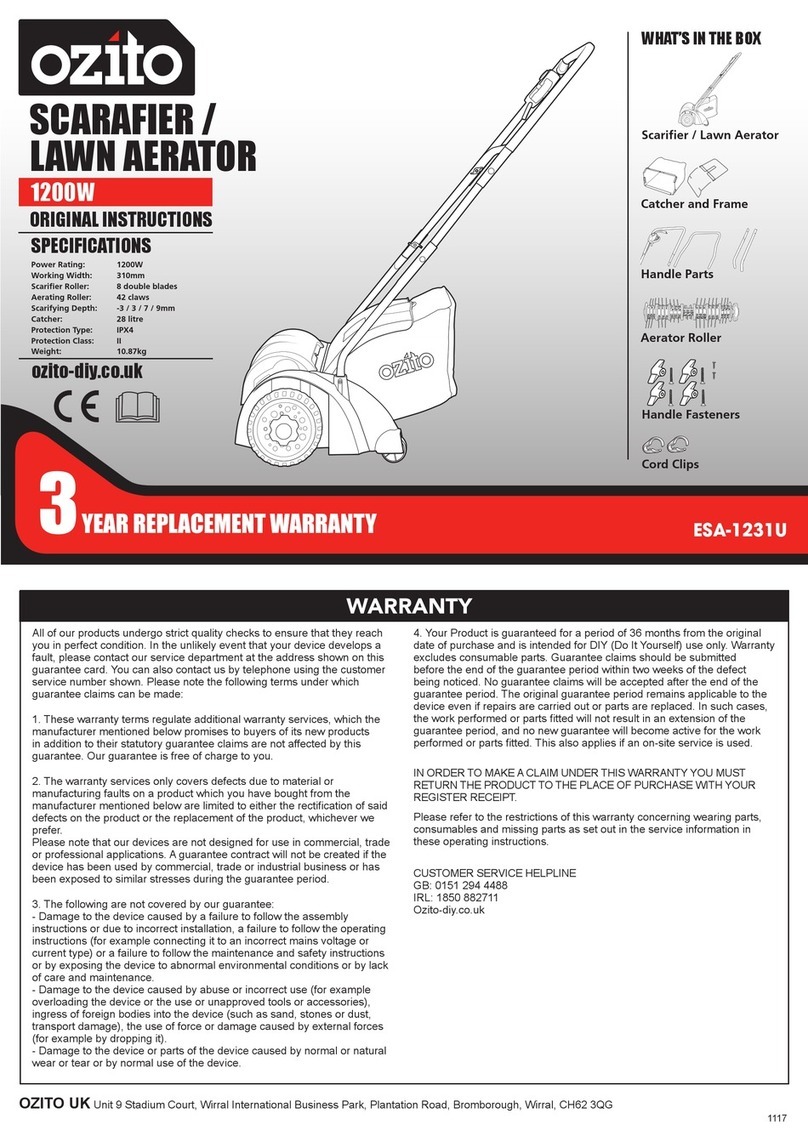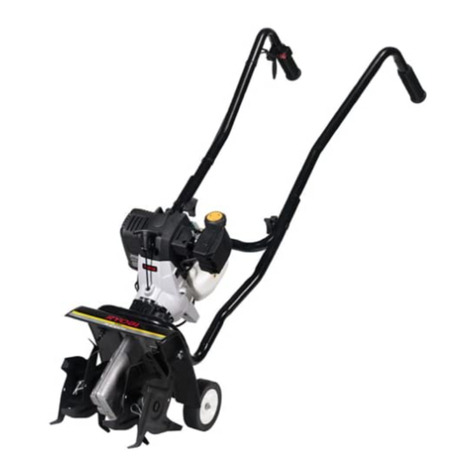SAFETY RULES
CAUTION: ALWAYS DISCONNECT SPARK PLUG WIRE AND PLACE WIRE WHERE A
IT CANNOT CONTACT SPARK PLUG TO PREVENT ACCIDENTAL STARTING WHEN
SETTING-UP, TRANSPORTING, ADJUSTING OR MAKING REPAIRS BEFORE USE
Read the owner’s manual carefully Be thoroughly familiar with the controls and the proper use
of the petrol tiller. Know how to stop the petrol tiller and disengage the controls quickly.
• Keep the area of operation clear of all persons, particularly small children and pets.
• Thoroughly inspect the area where the petrol tiller is to be used and remove all foreign
objects. The tiller tines can throw rocks and other objects with enough force to cause injury.
• Avoid rotating tines. The rotating tines can cause injury. Keep away from the tine shield
whenever the engine is running. If you need to adjust the tines or work around the tines for
any reason, always stop the engine. Disconnect the spark plug cap if you need to clean or
handle the tines.
• Keep shields in place. Guards and shields are designed to protect you from being hit by
thrown objects. They also help protect you from hot engine parts and moving components.
For your safety and the safety of others, keep all guards and shields in place when operating
the tiller.
• Wear protective clothing. Wearing protective clothing will reduce your risk of injury. Long
pants and eye protection reduce the risk of injuries from thrown objects. Sturdy shoes with
aggressive soles will help protect your feet and give you better traction on slopes or uneven
ground. Clothing worn by the operator should be close-tting. Loose clothing should not
be permitted because it may get caught in moving parts. Tie up or restrain long hair. Wear
footwear that will improve footing on slippery surfaces.
• Turn engine off when not tilling. If you need to leave the tiller for any reason, even just to
inspect the area ahead, always stop the engine.
• Do not make any modications to your tiller. Modifying your tiller can make your tiller
unsafe.
• Do not smoke while refuelling. This is potentially dangerous as it may ignite the fuel and
cause an explosion.
• Take care not to spill fuel. When refuelling the tiller ensure that the motor has been
switched off. Prevent the spilling of fuel as this may also ignite with the hot motor. Never
refuel whilst the engine running.
• Be careful where you store the tiller. Store the tiller in a dry area away from ammable
liquids.
• Ensure bystanders keep a safe distance. The tiller emits exhaust fumes.
• Ensure you use oil-mix fuel. Ensure that you mix 40 parts unleaded fuel to 1 part engine
grade oil. If not, the engine will overheat and cause damage to your tiller.
• Never ll fuel tank indoors. Never ll fuel tank when engine is running or hot. Do not smoke
when lling fuel tank.
• Replace fuel tank cap securely and wipe up spilled fuel.
• Never remove the fuel tank cap or add fuel to a running or hot engine.
• Never store fuel or petrol tiller with fuel in the tank inside a building where fumes may
reach an open ame.
• Never allow children or young teenagers to operate the petrol tiller. Keep them away
while it is operating.
• Never allow adults to operate the petrol tiller without proper instruction.
• Always wear safety glasses or eye shields during operation or while performing an
adjustment or repair to protect your eyes from foreign objects that may be thrown from the
petrol tiller.
• Exercise extreme caution when operating on or crossing gravel drives, walks, or
roads. Stay alert for hidden hazards or trafc.
• Exercise caution to avoid slipping or falling
• Never operate the petrol tiller at high transport speeds on slippery surfaces. Look
behind and use care when backing.
• Never operate the petrol tiller without good visibility or light.
• Do not run the engine indoors. The exhaust fumes are dangerous (containing CARBON
MONOXIDE, an ODOURLESS and DEADLY GAS).
• Take all possible precautions when leaving the petrol tiller unattended. Stop the engine.
• Do not overload the petrol tiller capacity by attempting to tilt too deep at too fast a rate.
• Keep the mini tiller/cultivator in safe working condition.
• Check all fasteners at frequent intervals for proper tightness.
• After striking a foreign object, stop the engine (motor). Remove the wire from the spark
plug, and keep the wire away from the plug to prevent accidental starting. Thoroughly inspect
the petrol tiller for any damage, and repair the damage before restarting and operating the
petrol tiller.
• If the petrol tiller should start to vibrate abnormally, stop the engine (motor) and check
immediately for the cause. Vibration is generally a warning of trouble. Stop the engine
(motor) whenever you leave the operating position. Also, disconnect the spark plug wire
before unclogging the tines and when making any repairs, adjustments, or inspections.
• When cleaning, repairing, or inspecting, shut off the engine and make certain all
moving parts have stopped.
• Never attempt to make any adjustments while the engine is running.
RISK OF EXPLOSION OR FIRE
What can happen:
• Spilled petrol and its vapours can become ignited from cigarette sparks, electrical arcing,
exhaust gases and hot engine components such as the mufer.
• Heat will expand fuel in the tank which could result in a re.
• Operating the tool in an explosive environment could result in a re.
• Mufer exhaust heat can damage painted surfaces, melt any materials sensitive to heat
(such as siding plastic, rubber or vinyl) and damage live plants. Keep hot tool away from
other objects.
• Improperly stored fuel could lead to accidental ignition. Fuel improperly secured could get
into the hands of children or other unqualied persons.
How to prevent it:
• Shut off engine and allow it to cool before adding fuel to the tank.
• Use care when lling the tank to avoid spilling fuel. Move tool away from fuelling area
before starting engine.
• Keep maximum fuel level 20mm below top of tank to allow for expansion.
• Operate and refuel in well ventilated areas free from obstructions.
• Store fuel in a approved container (AS/NZS 2906-1999) for petrol. Store in a secure
location away from the work area. Make sure the container is clearly marked “fuel”.
RISK TO BREATHING
What can happen:
• Breathing exhaust fumes can cause serious injury or death.
How to prevent it:
• Operate tool in a well ventilated area. Avoid enclosed areas.
• Never operate unit in a location occupied by other people or animals.
SAVE THESE INSTRUCTIONS
1) Work area
a) Keep work area clean and well lit. Cluttered and dark areas invite accidents.
b)
Do not operate petrol tools in explosive atmospheres, such as in the presence of
ammable liquids, gases, or dust. Power tools create sparks which may ignite the dust
or fumes.
c) Keep children and bystanders away while operating a petrol tool.
Distractions can cause you to lose control.
2) Personal safety
a) Stay alert, watch what you are doing and use common sense when operating a
petrol tool. Do not use a power tool while you are tired or under the inuence of drugs,
alcohol, or medication. A moment of inattention while operating power tools may result in
serious personal injury.
b) Use safety equipment. Always wear eye protection. Safety equipment such as a
dust mask, non-skid safety shoes, hard hat, or hearing protection used for appropriate
conditions will reduce personal injuries.
c) Remove any adjusting key or wrench before turning the tool on. A wrench or a key
that is left attached to a rotating part of the petrol tool may result in personal injury.
d) Do not overreach. Keep proper footing and balance at all times. This enables better
control of the petrol tool in unexpected situations.
e) Dress properly. Do not wear loose clothing or jewellery. Keep your hair, clothing and
gloves away from moving parts. Loose clothes, jewellery or long hair can be caught in
moving parts.
f) If devices are provided for the connection of dust extraction and collection
facilities ensure that these are connected and properly used. Use of these devices
can reduce dust-related hazards.
3) Petrol tool use and care
a) Do not force the petrol tool. Use the correct petrol tool for your application. The
correct petrol tool will do the job better and safer at the rate for which it was designed.
b) Do not use the petrol tool if the switch does not turn it on and off. Any petrol tool that
cannot be controlled with the switch is dangerous and must be repaired.
c) Turn tool off completely before making any adjustments, changing accessories,
or storing petrol tools. Such preventive safety measures reduce the risk of starting the
petrol tool accidentally. Hair can be caught in moving parts.
d) Store idle petrol tools out of the reach of children and do not allow persons
unfamiliar with the petrol tool or these instructions to operate the petrol tool. Petrol
tools are dangerous in the hands of untrained users.
e) Maintain petrol tools. Check for misalignment or binding of moving parts, breakage
of parts and any other condition that may affect the petrol tool’s operation. If
damaged, have the petrol tool repaired before use. Many accidents are caused by poorly
maintained petrol tools.
f) Keep cutting tools sharp and clean. Properly maintained cutting tools with sharp
cutting edges are less likely to bind and are easier to control.
g)Use the petrol tool, accessories and tool bits etc., In accordance with these
instructions and in the manner intended for the particular type of petrol tool, taking
into account the working conditions and the work to be performed. Use of the petrol
tool for operations different from intended could result in a hazardous situation.
h) This appliance is not intended for use by persons (including children) with reduced
physical, sensory or mental capabilities, or lack of experience and knowledge,
unless they have been given supervision or instruction concerning use of the appliance
by a person responsible for their safety.
i) Children should be supervised to ensure that they do not play with the appliance.
4) Service
a) Have your petrol tool serviced by a qualied repair personnel using only identical
replacement parts. This will ensure that the safety of the petrol tool is maintained.
ADDITIONAL SAFETY INSTRUCTIONS FOR PETROL TILLERS
SAFETY INSTRUCTIONS



